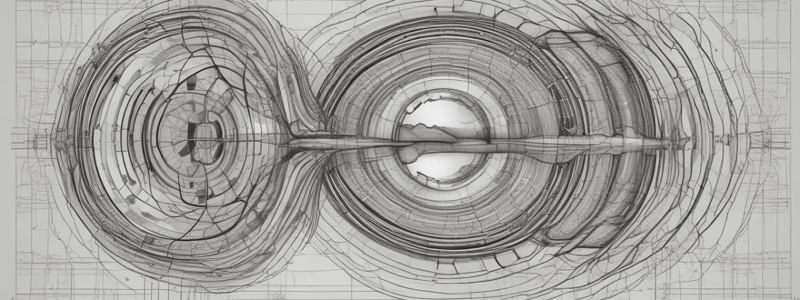Podcast
Questions and Answers
What is the main advantage of increasing the line density in ultrasound imaging?
What is the main advantage of increasing the line density in ultrasound imaging?
- Reduced instrument resolution
- Improved temporal resolution
- Faster data acquisition
- Enhanced image accuracy and detail (correct)
What is the primary factor that determines the line density in ultrasound imaging?
What is the primary factor that determines the line density in ultrasound imaging?
- The bit depth of the image memory
- PRF (Pulses per Frame Rate)
- The capacity to differentiate between tissues
- The spacing between each beam (correct)
What is the effect of increasing the number of pulses per line in multifocal technology?
What is the effect of increasing the number of pulses per line in multifocal technology?
- Increased frame rate
- Reduced frame rate (correct)
- Improved image accuracy
- Reduced contrast resolution
What is contrast resolution dependent on in an ultrasound system?
What is contrast resolution dependent on in an ultrasound system?
What is the relationship between frame rate and line density in ultrasound imaging?
What is the relationship between frame rate and line density in ultrasound imaging?
What is the benefit of disabling multifocal technology in ultrasound imaging?
What is the benefit of disabling multifocal technology in ultrasound imaging?
What is the term for the artifacts that can occur due to poor elevational resolution?
What is the term for the artifacts that can occur due to poor elevational resolution?
What is the primary factor that affects temporal resolution in ultrasound systems?
What is the primary factor that affects temporal resolution in ultrasound systems?
What is the unit of measurement for temporal resolution?
What is the unit of measurement for temporal resolution?
What is the effect of decreasing imaging depth on the achievable frame rate?
What is the effect of decreasing imaging depth on the achievable frame rate?
What is the trade-off for reducing line density to increase frame rate?
What is the trade-off for reducing line density to increase frame rate?
What is the benefit of narrowing the imaging sector to improve frame rate?
What is the benefit of narrowing the imaging sector to improve frame rate?
What is the primary factor that determines axial resolution in ultrasound?
What is the primary factor that determines axial resolution in ultrasound?
Which of the following is a characteristic of lateral resolution?
Which of the following is a characteristic of lateral resolution?
What is the term used to describe the width of the imaging plane in ultrasound?
What is the term used to describe the width of the imaging plane in ultrasound?
What is the result of inadequate elevational resolution in ultrasound imaging?
What is the result of inadequate elevational resolution in ultrasound imaging?
Which of the following is NOT a determinant of axial resolution?
Which of the following is NOT a determinant of axial resolution?
What is the purpose of the LATA and LARD mnemonics?
What is the purpose of the LATA and LARD mnemonics?
In which orientation is lateral resolution measured?
In which orientation is lateral resolution measured?
What is the advantage of using a higher frequency transducer?
What is the advantage of using a higher frequency transducer?
Flashcards are hidden until you start studying
Study Notes
Ultrasound Resolution
- Axial resolution: front to back, parallel to beam, determined by pulse length
- Lateral resolution: side by side, perpendicular to beam, determined by beam width
- Mnemonic for axial and lateral resolution: LARD (Linear, Axial, Range, Depth) and LATA (Lateral, Azimuthal, Transverse, Angular)
Elevational Resolution (Slice Thickness)
- Describes the width of the imaging plane, perpendicular to the image plane
- Influenced by the height of the transducer's element
- Inadequate elevational resolution can lead to partial-volume artifacts
Temporal Resolution
- Refers to the capacity of an ultrasound system to depict motion and changes in anatomy over time
- Directly affected by the frame rate, which is the frequency at which consecutive images are captured and displayed
- Measured in Hertz (Hz), representing the number of frames captured per second
- Factors affecting frame rate: speed of sound, imaging depth
- Strategies to improve frame rate:
- Narrow the imaging sector
- Decrease imaging depth
- Reduce line density
- Disable multifocal technology
Line Density in Ultrasound Imaging
- Refers to the number of scan lines per unit area in an ultrasound image
- Achieved with closely packed lines, improving image accuracy and detail (spatial resolution)
- Higher line density can reduce temporal resolution
Contrast Resolution
- Refers to the ultrasound system's capacity to differentiate between tissues with varying echogenic properties
- Dependent on the bit depth - the number of bits per pixel stored in the image memory
- Increasing the number of bits per pixel allows for more shades of gray, enhancing contrast resolution
Studying That Suits You
Use AI to generate personalized quizzes and flashcards to suit your learning preferences.




